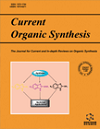-
oa Editorial [Hot Topic: 2-Isoxazolines in Synthesis (Guest Editor: Cindy C. Browder)]
- Source: Current Organic Synthesis, Volume 8, Issue 5, Oct 2011, p. 615 - 615
-
- 01 Oct 2011
- Previous Article
- Table of Contents
- Next Article
Abstract
Over the past decade, 2-isoxazolines (Δ2-isoxazolines, 4,5-dihydroisoxazoles) have seen a vast increase in their use, both as intermediates in the synthesis of natural and unnatural products, and as bioisosteric functionalities in medicinal compounds. As a result, a number of new methods and expansions in traditional techniques have emerged for the preparation and derivatization of 2-isoxazolines. Considering the burgeoning use of these versatile synthetic compounds since the 1990s, few reviews have appeared in the literature addressing the copious and significant developments in this area. This issue aims to provide the most thorough, updated guide to the chemistry of 2-isoxazolines since Grunager's 1991 volume in The Chemistry of Heterocyclic Compounds (John Wiley and Sons, Inc.: New York, 1991). Nitrile oxide cycloaddition (NOC) reactions remain the most common method for the preparation of 2-isoxazolines, and Digamber Rane and Mukund Sibi address current trends in intermolecular reactions towards these compounds. Intramolecular nitrile oxide cycloadditions receive separate treatment in my article. Notably, a number of asymmetric NOC reactions have emerged in the past decade, which receive special attention in both Drs. Rane and Sibi's as well as my reviews. As the scope of NOC approaches to 2-isoxazolines has broadened, additional non-cycloaddition methods have emerged for the preparation of these compounds. As explored by Michael Mosher, these include C-O and C-N bond-forming reactions, as well as reductions of the related 2-isoxazoline N-oxides. Finally, the utility of 2-isoxazolines owes much to the many methods for their selective cleavage, including oxidative and reductive cleavage as well as thermal, photochemical, and hydrolysis processes. Jaipal R. Nagireddy, Mohammed- Abdul Raheem, Jamie Haner and William Tam have painstakingly compiled the extensive literature in this area. While we wish to have covered every aspect of modern 2-isoxazoline chemistry, the preparation of 2-isoxazolines through solid-phase and combinatorial approaches, as well as the use of 2-isoxazolines as intermediates in the synthesis of natural products and drug compounds are notably absent from this issue. We anticipate reviews on these topics to appear elsewhere in the near future. This Special Issue of Current Organic Synthesis would not be possible without the hard work and dedication of each of the contributors. I am particularly grateful for the insightful comments provided by the referees, and wish to thank my colleagues at Northern Arizona University for their support and assistance in preparing and compiling these articles. Most importantly, the efforts of Ms. Humaira Hashmi, Sr. Manager Publications and Ms. Maria Baig, Asst. Manager Publications (Current Organic Synthesis, Bentham Science Publishers) were invaluable in developing and coordinating this issue.


